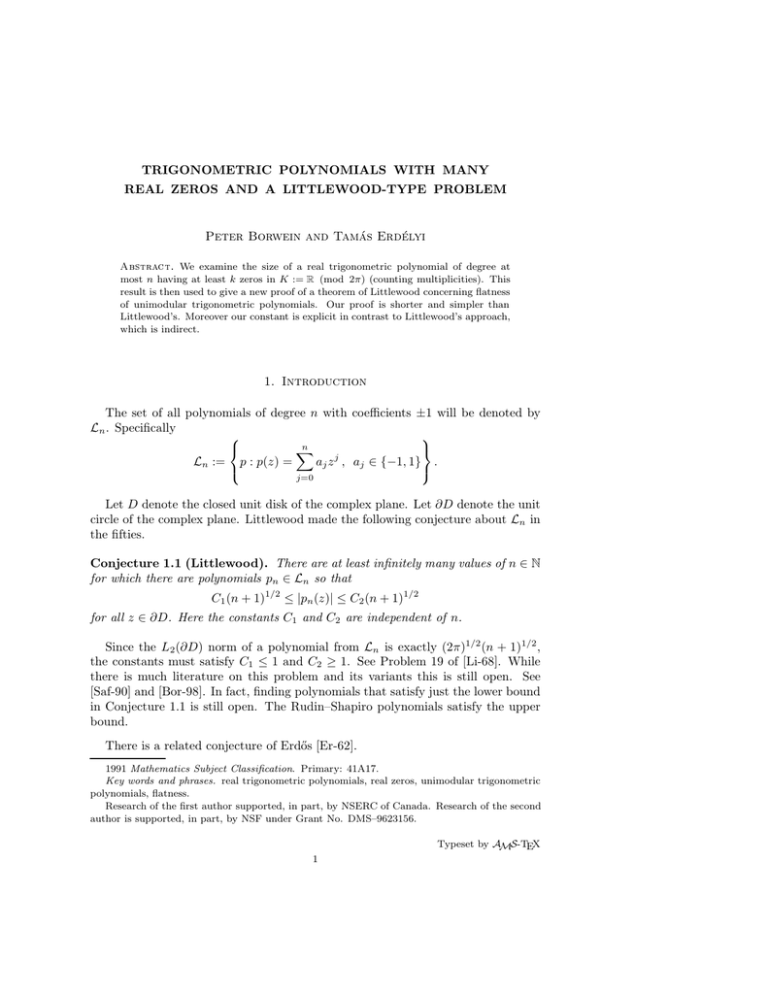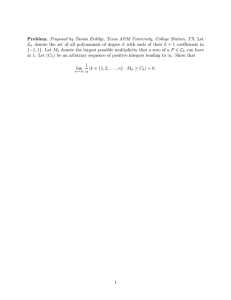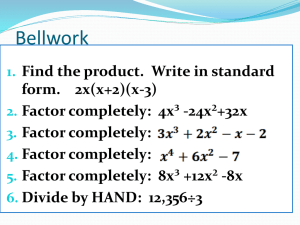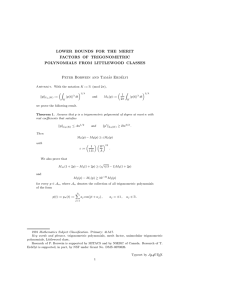TRIGONOMETRIC POLYNOMIALS WITH MANY REAL ZEROS AND A LITTLEWOOD-TYPE PROBLEM as Erd´
advertisement

TRIGONOMETRIC POLYNOMIALS WITH MANY
REAL ZEROS AND A LITTLEWOOD-TYPE PROBLEM
Peter Borwein and Tamás Erdélyi
Abstract. We examine the size of a real trigonometric polynomial of degree at
most n having at least k zeros in K := R (mod 2π) (counting multiplicities). This
result is then used to give a new proof of a theorem of Littlewood concerning flatness
of unimodular trigonometric polynomials. Our proof is shorter and simpler than
Littlewood’s. Moreover our constant is explicit in contrast to Littlewood’s approach,
which is indirect.
1. Introduction
The set of all polynomials of degree n with coefficients ±1 will be denoted by
Ln . Specifically
n
X
aj z j , aj ∈ {−1, 1} .
Ln := p : p(z) =
j=0
Let D denote the closed unit disk of the complex plane. Let ∂D denote the unit
circle of the complex plane. Littlewood made the following conjecture about Ln in
the fifties.
Conjecture 1.1 (Littlewood). There are at least infinitely many values of n ∈ N
for which there are polynomials pn ∈ Ln so that
C1 (n + 1)1/2 ≤ |pn (z)| ≤ C2 (n + 1)1/2
for all z ∈ ∂D. Here the constants C1 and C2 are independent of n.
Since the L2 (∂D) norm of a polynomial from Ln is exactly (2π)1/2 (n + 1)1/2 ,
the constants must satisfy C1 ≤ 1 and C2 ≥ 1. See Problem 19 of [Li-68]. While
there is much literature on this problem and its variants this is still open. See
[Saf-90] and [Bor-98]. In fact, finding polynomials that satisfy just the lower bound
in Conjecture 1.1 is still open. The Rudin–Shapiro polynomials satisfy the upper
bound.
There is a related conjecture of Erdős [Er-62].
1991 Mathematics Subject Classification. Primary: 41A17.
Key words and phrases. real trigonometric polynomials, real zeros, unimodular trigonometric
polynomials, flatness.
Research of the first author supported, in part, by NSERC of Canada. Research of the second
author is supported, in part, by NSF under Grant No. DMS–9623156.
Typeset by AMS-TEX
1
2
PETER BORWEIN AND TAMÁS ERDÉLYI
Conjecture 1.2 (Erdős). There is a constant ε > 0 (independent of n) so that
max |pn (z)| ≥ (1 + ε)(n + 1)1/2
z∈∂D
for every pn ∈ Ln and n ∈ N. That is, the constant C2 in Conjecture 1.1 must be
bounded away from 1 (independently of n).
This conjecture is also open. Kahane [Kah-85], however, shows that if the polynomials are allowed to have complex coefficients of modulus 1 then Conjecture 1.1
holds and Conjecture 1.2 fails. That is, for every ε > 0 there are infinitely many
values of n ∈ N for which there are polynomials pn of degree n with complex
coefficients of modulus 1 that satisfy
(1 − ε)(n + 1)1/2 ≤ |pn (z)| ≤ (1 + ε)(n + 1)1/2
for all z ∈ ∂D. Beck [Bec-91] extends Kahane’s result (with two constants C1 > 0
and C2 > 0 instead of 1 − ε and 1 + ε) for the class of polynomials of degree n
whose coefficients are 400th roots of unity.
Our main result is a reproving of Conjecture 1.2 for real trigonometric polynomials. This is Corollary 2.4 of the next section. Littlewood gives a proof of this in
[Li-61] and explores related issues in [Li-62], [Li-66a], and [Li-66b]. Our approach is
via Theorem 2.1 which estimates the measure of the set where a real trigonometric
polynomial of degree at most n with at least k zeros in K := R (mod 2π) is small.
There are two reasons for doing this. First the approach is, we believe, easier and
secondly it leads to explicit constants.
2. New Results
Let K := R (mod 2π). For the sake of brevity the uniform norm of a continuous
function p on K will be denoted by kpkK := kpkL∞ (K) . Let Tn denote the set of all
real trigonometric polynomials of degree at most n, and let Tn,k denote the subset
of those elements of Tn that have at least k zeros in K (counting multiplicities).
Theorem 2.1. Suppose p ∈ Tn has at least k zeros in K (counting multiplicities).
Let α ∈ (0, 1). Then
m{t ∈ K : |p(t)| ≤ αkpkK } ≥
αk
,
en
where m(A) denotes the one-dimensional Lebesgue measure of A ⊂ K.
Theorem 2.2. We have
kpkL1 (K)
c2 k
c1 k
2π 1 −
≤ sup
≤ 2π 1 −
n
n
p∈Tn,k kpkL∞ (K)
for some absolute constants 0 < c1 < c2 .
TRIGONOMETRIC POLYNOMIALS WITH MANY REAL ZEROS
3
Theorem 2.3. Assume that p ∈ Tn satisfies
kpkL2(K) ≤ An1/2
(2.1)
and
kp0 kL2 (K) ≥ Bn3/2 .
(2.2)
Then there is a constant ε > 0 depending only on A and B such that
kpk2K ≥ (2π − ε)−1 kpk2L2 (K) .
(2.3)
Here
π3 B 6
1024e A6
ε=
works.
Corollary 2.4. Let p ∈ Tn be of the form
p(t) =
n
X
ak cos(kt − γk ) ,
ak = ±1 ,
γk ∈ R ,
k = 1, 2, . . . , n .
k=1
Then there is a constant ε > 0 such that
kpk2K ≥ (2π − ε)−1 kpk2L2 (K) .
Here
ε :=
π3 1
1024e 27
works.
3. Proofs
To prove Theorem 2.1 we need the lemma below that is proved in [BE-95, E.11
of Section 5.1 on pages 236–237].
Lemma 3.1. Let p ∈ Tn , t0 ∈ K, and r > 0. Then p has at most enr|p(t0 )|−1 kpkK
zeros in the interval [t0 − r, t0 + r].
Proof of Theorem 2.1. Suppose p ∈ Tn has at least k zeros in K, and let α ∈ (0, 1).
Then
{t ∈ K : |p(t)| ≤ αkpkK }
can be written as the union of pairwise disjoint intervals Ij , j = 1, 2, . . . , m. Each
of the intervals Ij contains a point yj ∈ Ij such that
|p(yj )| = αkpkK .
4
PETER BORWEIN AND TAMÁS ERDÉLYI
Also, each zero of p from K is contained in one of the intervals Ij . Let µj denote
the
Pmnumber of zeros of p in Ij . Since p ∈ Tn has at least k zeros in K, we have
j=1 µj ≥ k. Note also that Lemma 3.1 implies that
µj ≤ en|Ij |(αkpkK )−1 kpkK =
en
|Ij | .
α
Therefore
k≤
m
X
m
µj ≤
j=1
en X
en
m({t ∈ K : |p(t)| ≤ αkpkK }) ,
|Ij | ≤
α j=1
α
and the result follows. Proof of Theorem 2.2. The upper bound of the theorem follows from Theorem 2.1
applied with α = 1/2. The lower bound follows by considering
n
,
p(t) := Dm (0)2 − Dm (kt)2 ∈ Tn,k
with
m=
2(k + 1)
where
m
Dm (t) =
1 X
+
cos jt
2 j=1
is the Dirichlet kernel of degree m. Proof of Theorem 2.3. First note that by Bernstein’s inequality for real trigonometric polynomials in L2 (K), we have B ≤ A. Assume that p ∈ Tn satisfies (2.1)
and (2.2) but (2.3) does not hold with ε = π. Then
(3.1)
M := kpkK ≤ (2π − π)−1/2 kpkL2 (K) ≤ π −1/2 An1/2 .
Combining this with Bernstein’s inequality we obtain
kp0 kK ≤ nkpkK ≤ π −1/2 An3/2 .
(3.2)
Using (2.2), we obtain
Z
|p0 (t)|2 dt
B 2 n3 ≤ kp0 k2L2 (K) =
K
Z
0
|p0 (t)| dt ≤ π −1/2 An3/2 kp0 kL1 (K) ,
≤ kp kK
K
that is
(3.3)
kp0 kL1 (K) ≥ π 1/2
B 2 3/2
n .
A
Associated with p ∈ Tn , M = kpkK , and γ ∈ [0, 1], let
(3.4)
Aγ = Aγ (p) = {t ∈ K : |p(t)| ≤ (1 − γ)M }
TRIGONOMETRIC POLYNOMIALS WITH MANY REAL ZEROS
5
and
Bγ = Bγ (p) = {t ∈ K : |p(t)| > (1 − γ)M } .
(3.5)
Since every horizontal line y = c intersects the graph of p ∈ Tn in at most 2n points
with x coordinates in K, we have
Z
(3.6)
Bγ
|p0 (t)| dt ≤ 4nγM ≤ 4nγπ −1/2 An1/2 ≤
if
4γπ −1/2 A ≤
π 1/2 B 2
2 A
π 1/2 B 2 3/2
n
2 A
γ≤
that is, if
π B2
.
8 A2
Now (3.3)–(3.6) give
Z
Aγ
|p0 (t)| dt ≥
π 1/2 B 2 3/2
n
2 A
with
γ=
π B2
.
8 A2
From this, with the help of (3.1) we can deduce that there is a
δ ∈ (−(1 − γ)M, (1 − γ)M )
such that p − δ has at least
π 1/2 B 2 3/2
2
A n
2(1 − γ)M
≥
π 1/2 B 2 n3/2
π 1/2 B 2
π B2
n3/2
≥
=
n
4 A M
4 A π −1/2 An1/2
4 A2
zeros in K. Therefore Theorem 2.1 yields that
o
n
o
n
γ
γ
kpkK ≥ m t ∈ K : |p(t) − δ| ≤ kpkK
m t ∈ K : |p(t)| ≤ 1 −
2
2
n
o
γ
≥ m t ∈ K : |p(t) − δ| ≤ kp − δkK
4
π2 B 4
1 γ π B2 n
≥
.
≥
e 4 4 A2 n
128e A4
Therefore
2πkpk2K − kpk2L2 (K) =
=
Z
K
(kpk2K − |p(t)|2 ) dt ≥
π2 B 4 γ
kpk2K
128e A4 2
π3 B 6
kpk2K .
1024e A6
We now conclude that
kpk2L2(K) ≤
and the result follows. 2π −
π3 B 6
1024e A6
kpk2K ,
6
PETER BORWEIN AND TAMÁS ERDÉLYI
Proof of Corollary 2.4. Let p ∈ Tn be of the given form. We have
kpk2L2 (K)
that is
=π
n
X
a2k = πn ,
k=1
kpkL2 (K) = π 1/2 n1/2 .
Also
kp0 k2L2 (K) = π
n
X
k 2 a2k = π
k=1
that is
kp0 kL2 (K) ≥
π
n(n + 1)(2n + 1)
≥ n3 ,
6
3
π 1/2
3
n3/2 .
Now the result follows from Theorem 2.3 with A := π 1/2 and B := (π/3)1/2 . References
Bec-95. J. Beck, Flat polynomials on the unit circle – note on a problem of Littlewood, Bull.
London Math. Soc. 23 (1991), 269–277.
Bor-98. P. Borwein, Some Old Problems on Polynomials with Integer Coefficients, in Approximation Theory IX, ed. C. Chui and L. Schumaker, Vanderbilt University Press (1998),
31–50.
BE-95. P. Borwein and T. Erdélyi, Polynomials and Polynomial Inequalities, Springer-Verlag,
New York, 1995.
Er-62. P. Erdős, An inequality for the maximum of trigonometric polynomials, Annales Polonica
Math. 12 (1962), 151–154.
Kah-85. J-P. Kahane, Sur les polynômes á coefficients unimodulaires, Bull. London Math. Soc
12 (1980), 321–342.
Li-61. J.E. Littlewood, On the mean value of certain trigonometric polynomials, Jour. London
Math. Soc. 36 (1961), 307–334.
Li-62. J.E. Littlewood, On the mean value of certain trigonometric polynomials (II), Jour.
London Math. Soc. 39 (1964), 511–552.
Li-66a. J.E. Littlewood, The real zeros and value distributions of real trigonometrical polynomials, Jour. London Math. Soc. 41 (1966), 336-342.
Li-66b. J.E. Littlewood, On polynomials
Soc. 41 (1966), 367–376.
P ±z
m
and
Pe
αm i z m ,
z = eθi , Jour. London Math.
Li-68. J.E. Littlewood, Some Problems in Real and Complex Analysis, Heath Mathematical
Monographs, Lexington, Massachusetts, 1968.
Saf-90. B. Saffari, Barker sequences and Littlewood’s “two sided conjectures” on polynomials
with ±1 coefficients, Séminaire d’Analyse Harmonique, 1989/90, Univ. Paris XI, Orsay,
1990, 139–151.
Department of Mathematics and Statistics, Simon Fraser University, Burnaby,
B.C., Canada V5A 1S6 (P. Borwein)
TRIGONOMETRIC POLYNOMIALS WITH MANY REAL ZEROS
7
E-mail address: pborwein@cecm.sfu.ca (Peter Borwein)
Department of Mathematics, Texas A&M University, College Station, Texas
77843 (T. Erd
elyi)
E-mail address: terdelyi@math.tamu.edu (Tamás Erdélyi)









